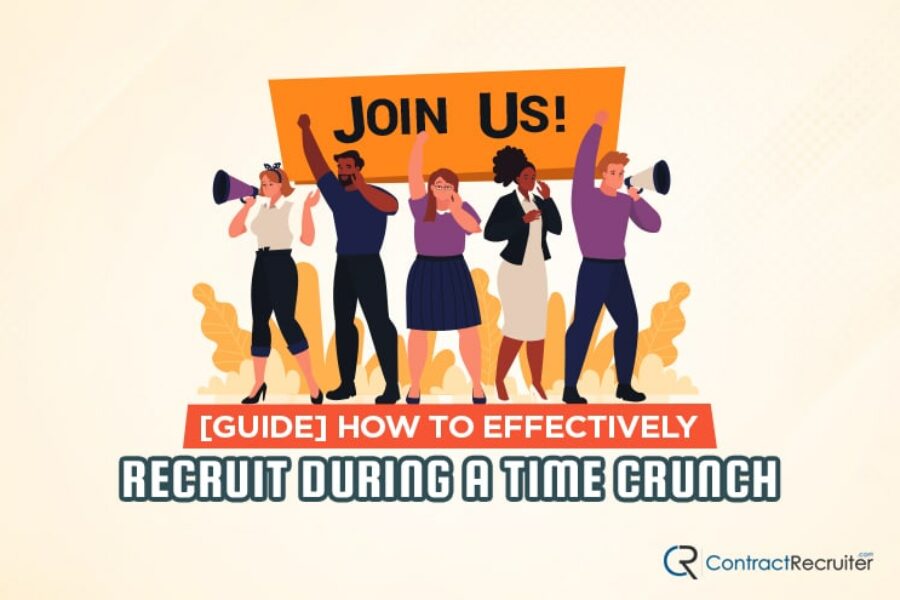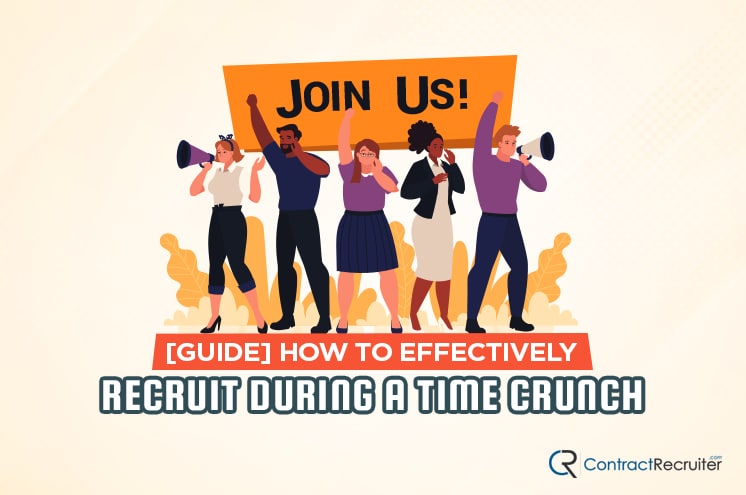Business ebbs and flows. The vagaries of the overall economy, the seasonality of a niche or an individual business, and even the availability of your marketing budget can create a push and pull on everything related to your business. Hiring is no exception.
There are many reasons why you may need to fill an open role during a time crunch. Maybe a critical employee left during a project where they’re most in demand. Maybe an employee encountered unexpected medical issues. Maybe slow attrition has built up such that, combined with increased seasonal demand, you need to fill entry-level seats as quickly as possible.
Hiring during a time crunch puts time-based pressure on an already strenuous process. It forces you to adapt to a short timeframe; you don’t have the luxury of a drawn-out process with multiple interviews and intensive skills testing. Instead, you need to make your best judgments as quickly as possible. At the same time, you must avoid using gut feelings or superficial traits to make a decision.
How can you recruit effectively during a time crunch? Here are the most important tips to keep in mind.
Don’t Skip the Basics
The foundation of effective hiring is laying the groundwork to make sure you’re picking the right people for the right roles. It can be very tempting to skip some of this groundwork due to the time it takes, but all you’re doing, if you do so, is minimizing the chances of finding a good, long-term hire.
What is the “groundwork” you need to do?
Create your candidate profile.
Creating your candidate profile means putting together a description of the role and the duties the employee will be tasked with performing. Then, you can select the essential skills necessary to succeed and the optional skills that would make a candidate an excellent choice. You can also pick deal-breakers that would remove even an otherwise great candidate from the running. It can take some time to assemble this profile, though the longer you’ve been doing it, the easier it will be.
You may also have an older document with the profile for the role from before your current employee left. If so, dust it off and update it to the modern demands of the role. Be sure not to use it as-is unless you review it to ensure it’s still accurate. After all, in a modern business, roles, duties, and job definitions change over time.
Create your job posting.
Your job posting is an essential part of recruiting. Unless you’re exclusively promoting from within or pursuing passive candidates, your job posting is where you’ll get most of your leads. A lot goes into a good job posting – much of which you should have on hand as a template anyway – but you always need to customize it for the specific role you’re looking to fill. Here’s a guide on making your job posting stand out.
Check existing resources.
Once your business is established, you should find it pretty rare that you need to start from absolute scratch when you’re recruiting. You should have existing resources you can check into.
- Previous candidates who applied to the role but didn’t make it at the time. Keeping a candidate pool warm is an evergreen strategy.
- Known passive candidates who may be interested now that a role has opened up. Engaging with passive candidates is a long-term project, but you may be able to accelerate the process to pull in a good candidate on short notice.
- Employee referrals to fill a role with people who have a recommendation from your existing employees. Of course, you can’t skip the whole process on the recommendation of a current employee, but you can get good leads.
- Internal promotions can allow you to fill higher-level roles with existing, known quantity employees, and then use a lower-pressure hiring process to fill the role they vacated.
These can give you excellent avenues to fill an open role on relatively short notice.
Manage expectations.
Sometimes you’re only looking for a temporary employee for a given project or a seasonal role, and you know you won’t have the opportunity to keep them on staff when the project finishes. In these cases, you must be up-front with that information. The last thing you need is to get three phases deep in the interview process with a promising candidate, only to mention that the role is temporary and have them drop out immediately.
Managing expectations is a critical part of hiring regardless of whether or not you have a time crunch on your hands, but it’s especially vital when wasted time is devastating.
Prune Overly-Restrictive Job Requirements
You may have heard this phrase before:
“Perfect is the enemy of good.”
A common trap people fall into – whether they’re learning a new skill, performing a new task, or hiring a new employee – is trying to get it perfect. 99% of the time, “good enough” is good enough. Perfection adds much more to the burden of the task and delays its completion.
In hiring, the most common source of this is creating an overdone, too-extensive candidate profile and rejecting any candidate that doesn’t match it 100%.
This often happens if you’re trying to replace a specific employee in a particular role, and your candidate profile is too much like a profile of the employee who left. No one will be identical to the person who left, and it’s essential to separate what is necessary from what is just trying to copy the former employee.
One of the biggest culprits is skills and experience lists. How many of the skills on your “must-have” list are genuinely essential? Most of the time, you can cut back on that list and open up your candidate pool to a broader group of people. Then, you have more ability to pick someone to fill the role. Everything else, you can train on the job.
It is, however, critical to recognize that some skills are actually essential. You need to determine whether or not you have time and the luxury of training a new employee to meet the demands of the role or if your time crunch means you need to have them hit the ground running.
It often comes down to the difference between a time crunch that demands your payroll be full or a time crunch that has specific deliverables and deadlines looming.
If you can cut back on time spent hiring in favor of more time training, this is often a much more effective way to hire an employee who will stick with your company. On the other hand, if you don’t have the luxury of time for training them, you need to be more stringent in finding people with the right requirements, and that can take longer.
Streamline the Hiring Process
The hiring process has many steps, from creating a job posting to final interviews, hiring, and onboarding. The more you can streamline and speed up, the better off you’ll be.
The biggest areas you can streamline are communication, skills testing, and interviewing.
When streamlining communication, you want to be responsive and rapid with your messaging. You have limited time to fill a role, so you need to be on the ball with communicating with your candidates, and they need to be quick with their responses. Make sure to be clear with your expectations; you miss out on great candidates if you eliminate them for transgressions they didn’t realize were rules to break.
“For businesses on an accelerated hiring spree, ensure candidates understand the immediate opportunities available to them and be honest about the long-term prospects. Is it a stopgap role only, or is there the prospect of longer-term employment and growth within the company? Candidates will appreciate the transparency.” – Forbes.
For skills testing, understand two things: whether or not you truly need it, and if you do, how to accelerate it.
Skills assessment platforms are often designed to proctor tests in a limited amount of time, but you need to be clear with your expectations. Anyone who reaches the point of the hiring process where they need to take an assessment should know that they have a limited number of days to do so. Again, it’s all about managing expectations.
For the interview process, it’s essential to be flexible. If you try to adhere to a strict in-person, during-business-hours schedule for interviews, you will run into scheduling conflicts and delays. Instead, consider:
- Sticking around after-hours to do interviews with people who work the same hours you do and, thus, are unavailable at those times.
- Allowing online interviews. You often don’t need to meet your candidates in person until later in the process; initial interviews may be easier to set up digitally and give you ample opportunity for the easy screening interviews and first-line discussions that make or break a candidate’s viability.
- Cutting back on the number of interviews. The more rounds of interviews you need to do, the longer it will take, especially if you have more than just a couple of viable candidates. If you can eliminate one interview and spread the questions from it to others, you cut back on the time investment significantly.
There are almost always ways you can streamline your hiring process. Often, simply picking up a good ATS platform and configuring it properly can go a long way towards assisting with the initial filtering and lead you to the more advanced, personal decisions that a human has to make.
Don’t Be Afraid to Throw Money at the Problem
You may have seen studies of today’s modern candidate-driven job market that show entry-level roles with shortages, while higher-level roles (and roles with better compensation) never seem to have a shortage. There’s a good reason for this, and that’s just money.
Money can speed up many processes and smooth out many bumps in the road.
- Invest more in an ATS to filter and manage your candidate list more effectively.
- Invest more in advertising a job listing to get more exposure in a shorter amount of time.
- Offer a higher base salary to attract better candidates to the role.
- Offer a bounty for employee referrals that successfully stick with the company.
You may also consider hiring a recruiter who specializes in rapid hiring. This will, of course, have an additional fee, but they will be more experienced with filling roles quickly and can help you get someone with boots on the ground faster than you can on your own.
Never Stop Hiring
A common problem with many companies is that they treat hiring as an individual task that happens when they have a role that needs to be filled. As such, their hiring process is shut down and mothballed when they don’t have an active need for new employees. Unpacking and starting up that process as necessary takes additional time.
Instead, take steps to keep your hiring process warmed up and ready at all times.
- Maintain a careers page and accept applications even if you’re not actively hiring.
- Maintain regular communication with your candidate pool via a regular newsletter.
- Create and maintain candidate profiles for every position within your company, no matter how filled they are or how loyal your current workers are.
- Make sure your hiring managers are practiced in the hiring process and can get started at the drop of a hat.
While it may seem like an unnecessary burden on your HR staff and hiring managers, being prepared when the need arises will speed up the process dramatically.
Sooner or later, every business runs into a time crunch in hiring, whether it’s the need to fill out a staff quickly or the need to replace an essential employee on short notice. Knowing how to accelerate your hiring process while maintaining accuracy and reducing turnover is an essential body of knowledge.
Do you have any questions or concerns about recruiting during a time crunch? If so, please feel free to leave a comment down below, and we’ll get a conversation started on the topic! We’d be more than happy to assist you and your company however we possibly can!








